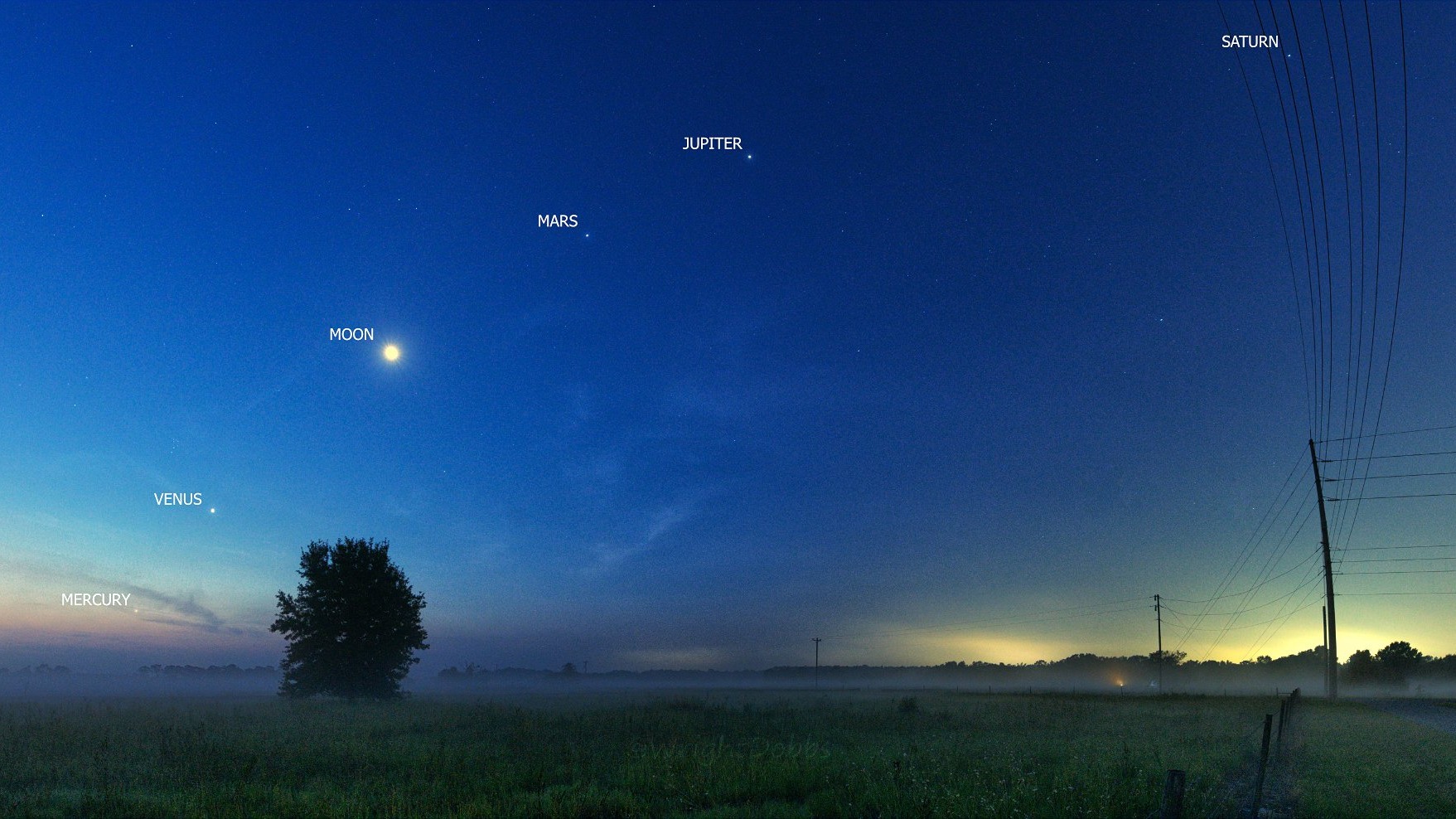See the rare alignment of 5 planets and the moon in this stunning night sky photo
You still have time to catch this rare lineup before it disappears until 2040.
The rare sight of five bright planets lining up with the moon wowed skywatchers around the world Friday, with some gearing up for more this weekend to see a planetary sight that won't happen again until 2040.
Throughout June, Mercury, Venus, Mars, Jupiter and Saturn have lined up from left to right, in their orbital order from the sun, before dawn in the southeastern sky. Early Friday (June 24), the moon joined the planet parade in an awesome sight captured by astrophotographer Wright Dobbs, a meteorologist for the U.S. National Weather Service in Tallahassee, Florida.
"Seeing the night sky is amazing and, knowing the rarity of these alignments, you have to take every opportunity to view and capture it," Dobbs told Space.com in an email after sharing an image of the fivesome from St. Cloud, Florida on Friday. Dobbs is a veteran night sky photographer and you can see more photos on their Facebook page, as well as on Twitter and Instagram as @wrightdobbs.
Related: Rare alignment of 5 planets peaks Friday with the crescent moon

Looking for a telescope for the next stargazing event? We recommend the Celestron Astro Fi 102 as the top pick in our best beginner's telescope guide.
The image was shot with a Sony a7ii, and was composed of a three-image panorama with a Sigma 14mm f/1.8 lens. Each image was exposed at ISO 1600, f/6.3, 15 seconds.
"It's certainly not the darkest place I've shot astrophotography from, but I love what the twilight glow added to the display of the planets in the morning sky," Dobbs said.
Other stunning views flowed in from social media.
Breaking space news, the latest updates on rocket launches, skywatching events and more!
LOOK UP: A bit hard to see here but if you look closely from left to right you’ll see Venus, the Moon, Mars and Jupiter! That’s just three of the five planets in alignment right now. Neat stuff 🪐 #planetaryalignment #planetparade @GoodDayAtlanta pic.twitter.com/KeHn2WnJ4oJune 24, 2022
Five-planetary alignment seen in Daanbantayan’ ✨LOOK: In case you missed the five-planetary alignment earlier today, here's a glimpse of the rare phenomenon in this photo captured by photographer John Reco Estrera. 📸: John Reco Estrera via Micah Sophia Marcellones pic.twitter.com/eiNqFoQ2LsJune 24, 2022
If you take a photograph of the five-world fiesta, let us know! You can send images and comments in to spacephotos@space.com.
While the show did hit its peak today (June 24), there's still ample time available to see the planets in alignment, along with the moon.
The moon moved through a planetary "meet and greet" in the predawn sky, passing Saturn on June 18, Jupiter on June 21 and Mars on June 22. The moon will continue its tour with a pass-by of Venus on June 26, and then end its tour with Mercury on June 27.
Related: The brightest planets in June's night sky: How to see them (and when)
If you're looking for a telescope or binoculars to see alignments like this event, our guides for the best binoculars deals and the best telescope deals now can help. Our best cameras for astrophotography and best lenses for astrophotography to prepare to capture the next stargazing sight in a photo.
Follow Elizabeth Howell on Twitter @howellspace. Follow us on Twitter @Spacedotcom and on Facebook.

Elizabeth Howell (she/her), Ph.D., was a staff writer in the spaceflight channel between 2022 and 2024 specializing in Canadian space news. She was contributing writer for Space.com for 10 years from 2012 to 2024. Elizabeth's reporting includes multiple exclusives with the White House, leading world coverage about a lost-and-found space tomato on the International Space Station, witnessing five human spaceflight launches on two continents, flying parabolic, working inside a spacesuit, and participating in a simulated Mars mission. Her latest book, "Why Am I Taller?" (ECW Press, 2022) is co-written with astronaut Dave Williams.

